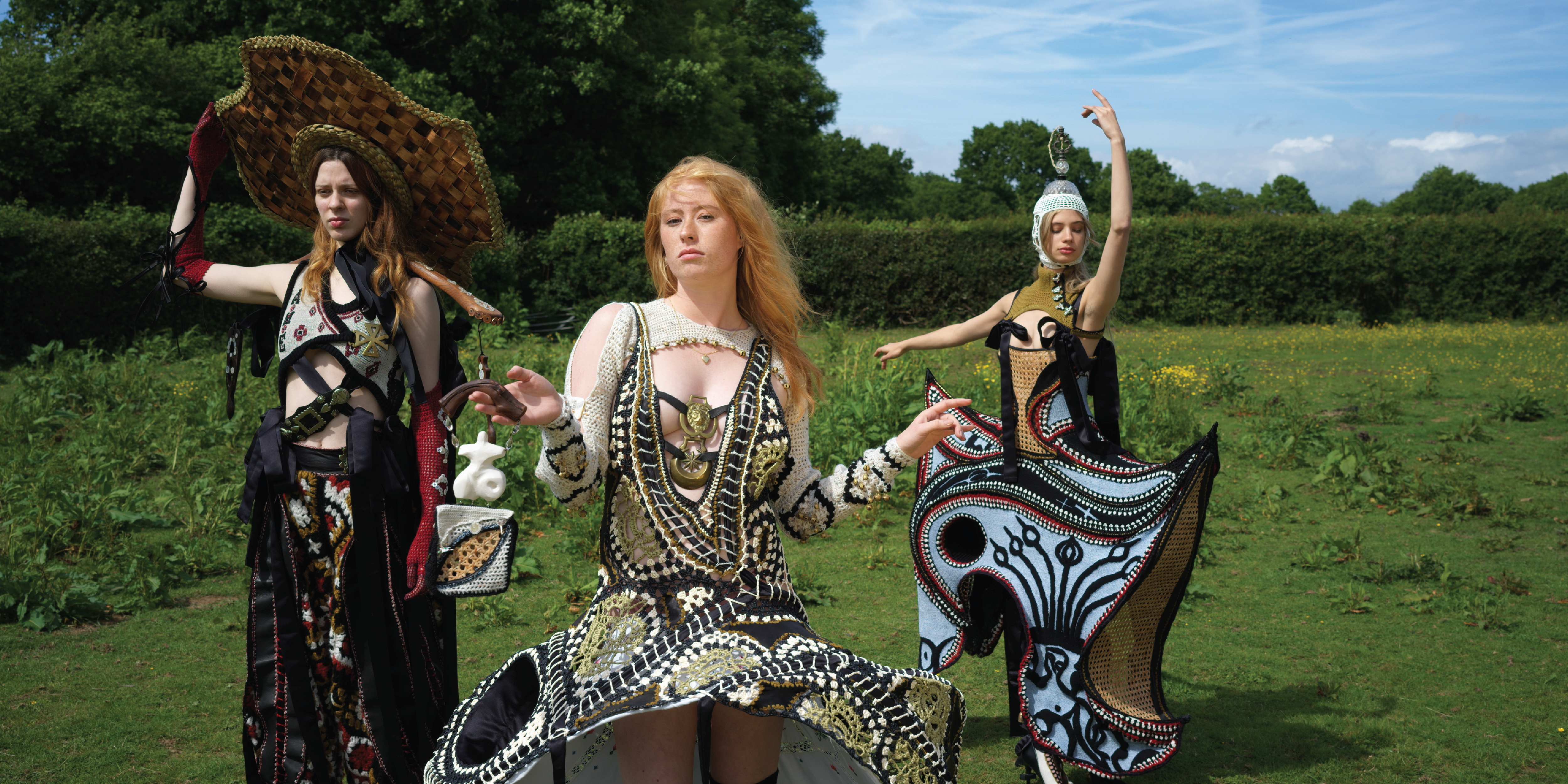“It’s crazy to have a family linked together through artistic style, but I love it.” The winner of CSM’s L’oréal Professionnel Young talent award on slow fashion, family creativity, and her hopes for the future.
Alice Morell Evans began her studies of BA Fashion: Fashion Design with Knitwear for Central Saint Martins in 2019. Last month she showcased her final collection, Old Hearth of Home, in the BA Fashion Show 2022. Through the use of repurposed chandeliers and chairs from her grandparents home and the traditional practice of knitwear, she created sculptural garments that reflect her childhood memories and Welsh customs. Winning her the title of this year’s L’Oréal Professionnel Young Talent Award, marks the first achievement of her emerging fashion career.
Below, Morrell Evans opens up about the inspiration behind her award winning final collection, connecting people to traditional handcrafting techniques, and her hopes to redefine knitwear.
Lizzy Zarrello: How has coming from a family of artists and creatives encouraged your work?
Alice Morell Evans: I’m fortunate to have a large creative family. I’ve never known anything different. There’s never been pressure to do a stereotypical job, my dad’s a freelancer and I’ve always known it to be the way to progress through an industry like this. I’ve loved textiles from a young age, and have tailors and seamstresses in my family. It’s always just been assumed that this would be the path I took from about age five. I’ve always had a clear stylistic direction with strong influences. I don’t know if it’s because of how I’ve been brought up or whether it’s my own personal taste. That’s where things get a bit misconstrued, me and my family all have such similar viewpoints and working points. Over lockdown, we were all working together. It’s a bit crazy to have a family that’s linked together through artistic style, but I absolutely love it.
LZ: What initially sparked your love for knitwear and fashion design?
AME: I started knitting when I was about four years old. I used to knit alongside my granny and picked it up very fast. She was a designer in the sixties and seventies. It’s hard to put it into words, but I like the idea that when you’re individually making each stitch, you’re knitting and crafting a garment. I feel like people are so far removed from that process. They don’t even know the type of stitch they’re wearing. I love the idea of connecting people back to these old techniques, learning how to use these skills again because knitwear is so” in fashion” at the moment. I want to connect people back to the artform’s roots.
LZ: How did you carry that traditional aspect of knitwear into your Old Hearth of Home collection?
AME: Tradition runs quite heavily through the collection. I was working with a lot of found materials. My grandad moved out of his home, so I was using pieces from his house. The balaclava has a tiny chandelier piece from his fitting room. I used my grandparents’ chair from their home in Wales and a lot of the yarn came from local sources and mills. There were a lot of historical references that I took, one being funeral stockings, which not many people know about. In South Wales and some parts of the U.K. people who were dying would knit their own stockings to be buried in and would put their initials along the top. This was my dissertation subject for my thesis. However, there isn’t really any proof of these things. They’re all buried, so there’s only small written sources and even then they’re few and far between. I was trying to make up my own version, just to see how it felt to be working toward a ceremonial process. I wanted to redefine the home space and things which feel familiar to us, so that people can emotionally connect and feel a story in the pieces.
LZ: Do you hope to continue creating sustainable clothing?
AME: I really want to redefine how we buy knitwear. I feel it’s too fast bringing out multiple collections a year. I’ve done freelancing with various designers and it’s intense, the workload and the high turnover. I wanted to create pieces which are bespoke and one off. Obviously you have to scale up somehow, but I want to keep working with found materials and making unique, authentic, simple pieces. Things that we hold and keep, giving hoarded materials a new narrative. I’ve collected a lot of little treasures and things that I really want to keep working with, especially waste products. I want to give new life to these garments.
LZ: What are your hopes for the future when it comes to your own design journey?
AME: My hope is people are more aware of what they’re buying and the story behind their clothing. I want to work in a collective, where I work with people who are excited about what I do and make the fashion industry more welcoming and approachable. My main hope is to be able to work through the whole process from start to finish and be able to feel the garments I’m working with rather than everything going digital. It sounds really unattainable in the current climate, but I hope to produce collections and things so infrequently that I really get to feel each garment and make sure that we don’t lose the personality in the items we wear.
Images courtesy of Alice Morall Evans.





